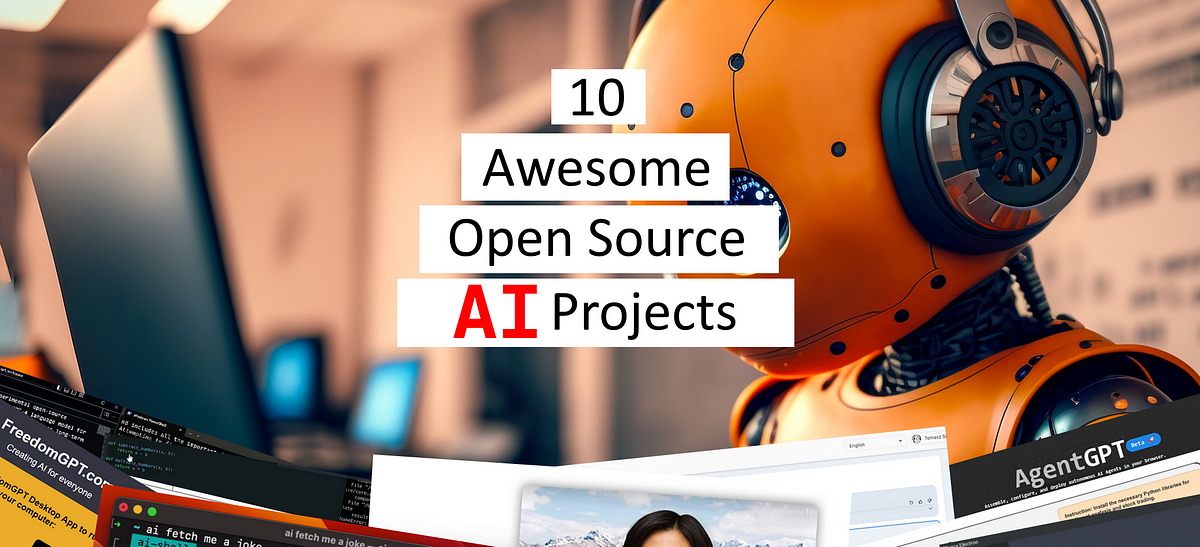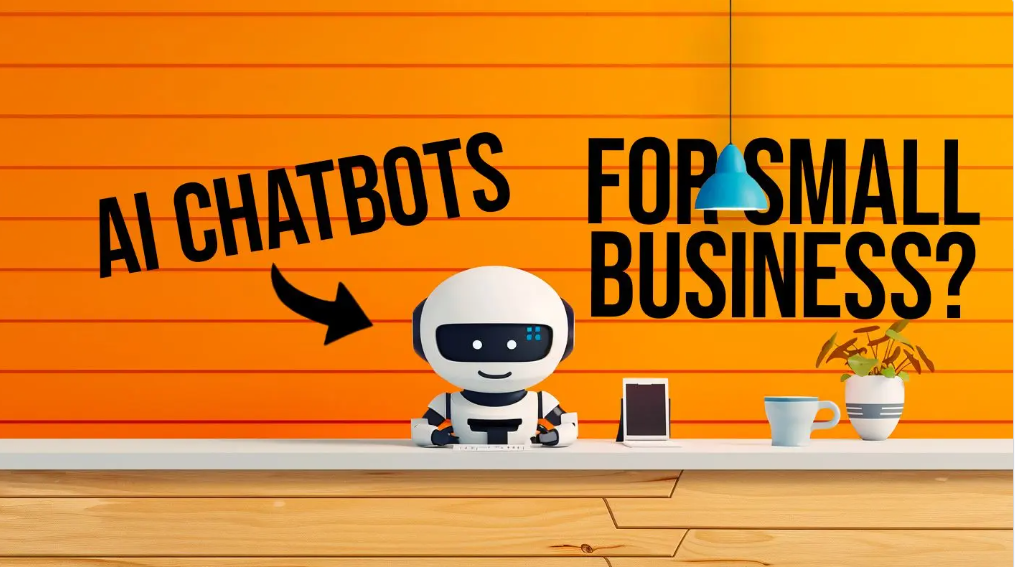Test AI på DIN hjemmeside på 60 sekunder
Se hvordan vores AI øjeblikkeligt analyserer din hjemmeside og skaber en personlig chatbot - uden registrering. Indtast blot din URL og se den arbejde!
Introduktion: The Golden Age of Open Source AI
Open source AI-projekter er forvandlet fra akademiske nysgerrigheder til produktionsklare værktøjer, der driver applikationer på tværs af brancher. De har demokratiseret adgangen til avanceret teknologi, muliggjort tilpasning, som proprietære systemer ikke kan matche, og skabt levende fællesskaber, der accelererer videndeling og innovation.
Denne artikel udforsker ti af de mest imponerende open source AI-projekter lige nu. Disse projekter skiller sig ikke kun ud for deres tekniske evner, men for deres indvirkning på det bredere AI-økosystem, deres innovative tilgange til løsning af komplekse problemer og deres potentiale til at forme fremtiden for udvikling af kunstig intelligens.
Fra store sprogmodeller, der konkurrerer med kommercielle tilbud, til specialiserede værktøjer, der løser specifikke problemer med bemærkelsesværdig effektivitet, repræsenterer disse projekter forkant med fællesskabsdrevet AI-udvikling. Uanset om du er en maskinlæringsforsker, en applikationsudvikler eller blot er interesseret i fremtiden for AI-teknologi, er disse projekter værd at se lige nu.
1. Hugging Face Transformers: Open Source AI Hub
Hvorfor det er banebrydende
Transformers-biblioteket i sig selv er imponerende nok - det giver en samlet API til at arbejde med tusindvis af forudtrænede modeller. Men det, der gør Hugging Face virkelig revolutionerende, er dets bredere økosystem:
Model Hub: Med over 150.000 frit tilgængelige præ-trænede modeller er Hub blevet verdens største lager af delte maskinlæringsmodeller, der spænder over sprog, vision, lyd og multimodale applikationer.
Datasæt: Tusindvis af kurerede, versionskontrollerede datasæt til træning og evaluering af modeller, der adresserer en af de vigtigste barrierer for AI-udvikling.
Spaces: En infrastruktur til implementering af interaktive maskinlæringsdemoer, der gør det muligt for alle at fremvise fungerende applikationer bygget på åbne modeller.
Collaborative Workflows: Git-baseret versionskontrol til modeller og datasæt, hvilket gør samarbejde om AI-projekter lige så strømlinet som softwareudvikling.
Virkelighed i verden
Hugging Face er blevet rygraden i utallige produktions-AI-systemer, fra startups til Fortune 500-virksomheder. Ved at levere en omfattende infrastruktur for hele maskinlæringslivscyklussen har det dramatisk reduceret barriererne for implementering af avancerede AI-funktioner.
Fællesskabsaspektet kan ikke overvurderes – Hugging Face har skabt en kultur for deling og samarbejde, der accelererer demokratiseringen af kunstig intelligens. Forskere kan dele nye arkitekturer, praktikere kan finde specialiserede modeller til deres use cases, og alle nyder godt af den kollektive viden og ressourcer.
Julien Chaumond, medstifter af Hugging Face, understreger dette fællesskabsfokus: "Vores mission er at demokratisere god maskinlæring. At lade alle bidrage og bygge videre på hinandens arbejde er den hurtigste vej til bedre AI."
Bemærkelsesværdige funktioner og muligheder
AutoClass Interface: Vælger automatisk den optimale præ-trænede model til specifikke opgaver, hvilket forenkler implementeringen.
Modelkort: Standardiseret dokumentation, der giver gennemsigtighed om modellens muligheder, begrænsninger og skævheder.
Optimalt bibliotek: Værktøjer til optimering af modelydelse på tværs af forskellige hardwareplatforme.
Evalueringssele: Standardiseret benchmarking for at sammenligne modellens ydeevne.
Hugging Face Transformers eksemplificerer, hvordan open source fundamentalt kan transformere en industri og skabe en fælles infrastruktur, der gavner hele AI-økosystemet.
2. LangChain: Opbygning af rammen for AI-applikationer
Hvorfor det er banebrydende
LangChain leverer en omfattende ramme til udvikling af applikationer drevet af sprogmodeller, der adresserer den kritiske kløft mellem rå AI-kapaciteter og nyttige applikationer:
Composable Chains: En fleksibel arkitektur til at kombinere flere AI-egenskaber i sammenhængende arbejdsgange.
Agenter: Implementering af autonome AI-systemer, der kan begrunde, planlægge og udføre opgaver ved at kalde forskellige værktøjer.
Hukommelsessystemer: Forskellige metoder til at fastholde kontekst i samtaler og processer over tid.
Retrieval-Augmented Generation: Værktøjer til jordforbindelse af sprogmodeller i specifikke datakilder, hvilket dramatisk forbedrer deres nøjagtighed og anvendelighed til domænespecifikke applikationer.
Værktøjsbrug: Standardiserede grænseflader til AI-systemer til at interagere med eksterne applikationer, databaser og API'er.
Virkning på den virkelige verden
LangChain er blevet væsentlig infrastruktur for tusindvis af AI-applikationer, fra automatisering af kundeservice til indholdsgenereringsplatforme til specialiserede forskningsværktøjer. Dens fleksible arkitektur giver udviklere mulighed for hurtigt at prototype og iterere på komplekse AI-applikationer, som ellers ville kræve måneders tilpasset udvikling.
Projektet eksemplificerer, hvordan open source accelererer innovation - ved at levere standardiserede komponenter til fælles mønstre i AI-applikationsudvikling, lader LangChain udviklere fokusere på unik værdi frem for at genopbygge grundlæggende infrastruktur.
Harrison Chase, medstifter af LangChain, beskriver denne etos: "Vores mål er at gøre det 10 gange hurtigere at bygge AI-applikationer, der rent faktisk er nyttige. Det betyder at løse alle de omkringliggende problemer – oprette forbindelse til datakilder, opretholde kontekst, udføre pålidelige arbejdsgange – ikke kun foretage API-kald til sprogmodeller."
Bemærkelsesværdige funktioner og muligheder
Dokumentindlæsere: Forudbyggede stik til snesevis af datakilder, fra PDF'er til websider til databaser.
Vector Stores: Integrationer med vektordatabaser til semantiske søgefunktioner.
Struktureret output: Værktøjer til pålideligt at udtrække strukturerede data fra ustruktureret tekst.
Evalueringsramme: Metoder til test og forbedring af applikationsydelse.
LangChain demonstrerer, hvordan open source-projekter kan skabe helt nye kategorier og hurtigt blive kritisk infrastruktur for en ny teknologi.
3. LocalAI: Bringer AI til din hardware
Hvorfor det er banebrydende
LocalAI giver en komplet platform til at køre AI-modeller lokalt med en arkitektur, der prioriterer tilgængelighed og praktisk funktionalitet:
API-kompatibilitet: Implementerer OpenAI-kompatible API'er lokalt, hvilket giver udviklere mulighed for at skifte mellem cloud- og lokal implementering uden kodeændringer.
Model Zoo: Forudkonfigureret adgang til en bred vifte af åbne modeller, fra sprogmodeller til billedgeneratorer til lydbehandling.
Hardwareoptimering: Automatisk konfiguration baseret på tilgængelig hardware, hvilket får modellerne til at køre effektivt på alt fra bærbare gaming-computere til specialiserede edge-enheder.
Kvantiseringsunderstøttelse: Indbyggede værktøjer til at komprimere modeller til at køre på begrænset hardware og samtidig opretholde acceptabel ydeevne.
Privacy-First Design: Fuldstændig datasuverænitet uden ekstern kommunikation, hvilket muliggør brugssager, hvor databeskyttelse er kritisk.
Virkelighed i verden
LocalAI har aktiveret helt nye kategorier af applikationer, hvor cloud-baseret AI ville være upraktisk, fra offline stemmeassistenter til privatlivsfølsomme medicinske applikationer til industrielle systemer i miljøer uden pålidelig forbindelse.
For udviklere og organisationer, der er bekymrede for databeskyttelse eller cloud-omkostninger, tilbyder LocalAI et praktisk alternativ, der bevarer de fleste muligheder, samtidig med at disse bekymringer løses. Det er særligt værdifuldt i regulerede industrier, hvor datastyringskrav gør cloud AI-tjenester udfordrende at implementere.
Enrico Bergamini, en nøglebidragyder til LocalAI, fremhæver dette fokus: "AI bør være tilgængelig for alle, ikke kun dem med massive skybudgetter eller specialiseret hardware. Vi beviser, at du kan køre imponerende AI-kapaciteter på den hardware, du allerede har."
Bemærkelsesværdige funktioner og muligheder
Container-baseret implementering: Enkel opsætning ved hjælp af Docker til ensartet implementering på tværs af miljøer.
Whisper API: Tale-til-tekst-funktioner, der kører helt lokalt.
Stabil diffusionsintegration: Billedgenerering uden eksterne tjenester.
Multi-modal support: Tekst, billede, lyd og video i et samlet system.
LocalAI demonstrerer, hvordan open source direkte kan adressere begrænsninger af kommercielle tilgange, skabe alternativer, der prioriterer forskellige afvejninger og muliggør nye use cases.
4. Ollama: Forenkling af lokal LLM-implementering
Hvorfor det er banebrydende
Ollama kombinerer teknisk sofistikering med enestående brugervenlighed for at gøre lokal AI tilgængelig:
One-Line Installation: Kom godt i gang kræver kun en enkelt kommando uden kompleks konfiguration eller afhængigheder.
Modelbibliotek: En kurateret samling af optimerede modeller, hver med forskellige muligheder og ressourcekrav.
Kommandolinjegrænseflade: Enkle, intuitive kommandoer til at downloade modeller og starte samtaler.
API-server: Indbygget API-endepunkt til integration af lokale modeller i applikationer og arbejdsgange.
Modelstyring: Enkle værktøjer til download, opdatering og fjernelse af modeller.
Virkning på den virkelige verden
Ollama har dramatisk udvidet publikum for lokale AI-modeller, hvilket gør dem tilgængelige for udviklere, forskere og entusiaster, der ellers kunne være blevet afskrækket af teknisk kompleksitet. Dette har fremskyndet eksperimentering og anvendelse på tværs af adskillige domæner.
For privatlivsbevidste brugere og organisationer giver Ollama en praktisk måde at udforske moderne AI-funktioner uden at sende følsomme data til eksterne tjenester. Dens enkelhed har gjort den særlig populær i undervisningsmiljøer, hvor den muliggør praktisk læring uden at kræve skykonti eller specialiseret hardware.
Matt Schulte, Ollama-bidragyder, forklarer dette fokus: "Vi ønskede at gøre driften af en lokal LLM lige så enkel som at installere en hvilken som helst anden applikation. Teknologien er kompleks, men at bruge den burde ikke være det."
Bemærkelsesværdige funktioner og muligheder
Modeltilpasning: Værktøjer til at skabe specialiserede versioner af modeller med tilpassede parametre.
Styring af samtalekontekst: Vedligeholder kontekst mellem forespørgsler til naturlige interaktioner.
GPU-acceleration: Automatisk udnyttelse af tilgængelige GPU-ressourcer for forbedret ydeevne.
Multimodal support: Udvider ud over tekst for at håndtere billeder og andre datatyper.
Ollama eksemplificerer princippet om, at virkelig transformativ teknologi bliver usynlig - hvilket får avancerede AI-egenskaber til at føles som ethvert andet værktøj på din computer.
Test AI på DIN hjemmeside på 60 sekunder
Se hvordan vores AI øjeblikkeligt analyserer din hjemmeside og skaber en personlig chatbot - uden registrering. Indtast blot din URL og se den arbejde!
5. Mistral AI: Sætter nye standarder for åbne modeller
Meta Description: Discover the most groundbreaking open source AI projects that are pushing boundaries, democratizing advanced technology, and creating new possibilities for developers worldwide.
Introduction: The Golden Age of Open Source AI
We're living in an unprecedented era for artificial intelligence development. While commercial AI solutions continue to make headlines, the open source community has become an extraordinary force driving innovation, accessibility, and transparency in AI technology. These community-driven projects are not just alternatives to proprietary systems—in many cases, they're pushing the boundaries of what's possible and setting new standards for the entire industry.
Open source AI projects have transformed from academic curiosities into production-ready tools powering applications across industries. They've democratized access to cutting-edge technology, enabled customization that proprietary systems can't match, and created vibrant communities that accelerate knowledge sharing and innovation.
This article explores ten of the most impressive open source AI projects right now. These projects stand out not just for their technical capabilities but for their impact on the broader AI ecosystem, their innovative approaches to solving complex problems, and their potential to shape the future of artificial intelligence development.
From large language models rivaling commercial offerings to specialized tools solving specific problems with remarkable efficiency, these projects represent the cutting edge of community-driven AI development. Whether you're a machine learning researcher, an application developer, or simply interested in the future of AI technology, these are the projects worth watching right now.
1. Hugging Face Transformers: The Open Source AI Hub
Hugging Face Transformers has evolved from a simple NLP library into what many consider the GitHub for machine learning—a comprehensive ecosystem that's fundamentally changing how AI models are developed, shared, and deployed.
Why It's Groundbreaking
The Transformers library itself is impressive enough—providing a unified API for working with thousands of pre-trained models. But what makes Hugging Face truly revolutionary is its broader ecosystem:
Model Hub: With over 150,000 freely available pre-trained models, the Hub has become the world's largest repository of shared machine learning models, spanning language, vision, audio, and multimodal applications.
Datasets: Thousands of curated, version-controlled datasets for training and evaluating models, addressing one of the most significant barriers to AI development.
Spaces: An infrastructure for deploying interactive machine learning demos, enabling anyone to showcase working applications built on open models.
Collaborative Workflows: Git-based version control for models and datasets, making collaboration on AI projects as streamlined as software development.
Real-World Impact
Hugging Face has become the backbone of countless production AI systems, from startups to Fortune 500 companies. By providing a comprehensive infrastructure for the entire machine learning lifecycle, it has dramatically reduced the barriers to implementing advanced AI capabilities.
The community aspect cannot be overstated—Hugging Face has created a culture of sharing and collaboration that's accelerating the democratization of AI. Researchers can share new architectures, practitioners can find specialized models for their use cases, and everyone benefits from the collective knowledge and resources.
Julien Chaumond, co-founder of Hugging Face, emphasizes this community focus: "Our mission is to democratize good machine learning. Having everyone contribute and build on each other's work is the fastest path to better AI."
Notable Features and Capabilities
AutoClass Interface: Automatically selects the optimal pre-trained model for specific tasks, simplifying implementation.
Model Cards: Standardized documentation that provides transparency about model capabilities, limitations, and biases.
Optimum Library: Tools for optimizing model performance across different hardware platforms.
Evaluation Harness: Standardized benchmarking to compare model performance.
Hugging Face Transformers exemplifies how open source can fundamentally transform an industry, creating a shared infrastructure that benefits the entire AI ecosystem.
2. LangChain: Building the Framework for AI Applications
LangChain emerged to solve a critical problem: while foundation models provide impressive capabilities, building practical applications with them requires significant additional infrastructure. In just over a year, it has become the de facto standard for developing LLM-powered applications.
Why It's Groundbreaking
LangChain provides a comprehensive framework for developing applications powered by language models, addressing the critical gap between raw AI capabilities and useful applications:
Composable Chains: A flexible architecture for combining multiple AI capabilities into coherent workflows.
Agents: Implementation of autonomous AI systems that can reason, plan, and execute tasks by calling different tools.
Memory Systems: Various methods for maintaining context in conversations and processes over time.
Retrieval-Augmented Generation: Tools for grounding language models in specific data sources, dramatically improving their accuracy and usefulness for domain-specific applications.
Tool Usage: Standardized interfaces for AI systems to interact with external applications, databases, and APIs.
Real-World Impact
LangChain has become essential infrastructure for thousands of AI applications, from customer service automation to content generation platforms to specialized research tools. Its flexible architecture allows developers to rapidly prototype and iterate on complex AI applications that would otherwise require months of custom development.
The project exemplifies how open source accelerates innovation—by providing standardized components for common patterns in AI application development, LangChain lets developers focus on unique value rather than rebuilding basic infrastructure.
Harrison Chase, co-founder of LangChain, describes this ethos: "Our goal is to make it 10x faster to build AI applications that are actually useful. That means solving all the surrounding problems—connecting to data sources, maintaining context, executing reliable workflows—not just making API calls to language models."
Notable Features and Capabilities
Document Loaders: Pre-built connectors for dozens of data sources, from PDFs to web pages to databases.
Vector Stores: Integrations with vector databases for semantic search capabilities.
Structured Output: Tools for reliably extracting structured data from unstructured text.
Evaluation Framework: Methods for testing and improving application performance.
LangChain demonstrates how open source projects can create entirely new categories and rapidly become critical infrastructure for an emerging technology.
3. LocalAI: Bringing AI to Your Hardware
LocalAI represents a powerful movement in AI development—bringing sophisticated models to local hardware without requiring cloud services or expensive specialized equipment.
Why It's Groundbreaking
LocalAI provides a complete platform for running AI models locally, with an architecture that prioritizes accessibility and practicality:
API Compatibility: Implements OpenAI-compatible APIs locally, allowing developers to switch between cloud and local deployment without code changes.
Model Zoo: Pre-configured access to a wide range of open models, from language models to image generators to audio processing.
Hardware Optimization: Automatic configuration based on available hardware, making models run efficiently on everything from gaming laptops to specialized edge devices.
Quantization Support: Built-in tools for compressing models to run on limited hardware while maintaining acceptable performance.
Privacy-First Design: Complete data sovereignty with no external communication, enabling use cases where data privacy is critical.
Real-World Impact
LocalAI has enabled entirely new categories of applications where cloud-based AI would be impractical, from offline voice assistants to privacy-sensitive medical applications to industrial systems in environments without reliable connectivity.
For developers and organizations concerned about data privacy or cloud costs, LocalAI provides a practical alternative that maintains most capabilities while addressing these concerns. It's particularly valuable in regulated industries where data governance requirements make cloud AI services challenging to implement.
Enrico Bergamini, a key contributor to LocalAI, highlights this focus: "AI should be accessible to everyone, not just those with massive cloud budgets or specialized hardware. We're proving that you can run impressive AI capabilities on the hardware you already have."
Notable Features and Capabilities
Container-Based Deployment: Simple setup using Docker for consistent deployment across environments.
Whisper API: Speech-to-text capabilities that run entirely locally.
Stable Diffusion Integration: Image generation without external services.
Multi-Modal Support: Text, image, audio, and video capabilities in a unified system.
LocalAI demonstrates how open source can directly address limitations of commercial approaches, creating alternatives that prioritize different trade-offs and enable new use cases.
4. Ollama: Simplifying Local LLM Deployment
While various projects focus on running large language models locally, Ollama stands out for making the process remarkably straightforward even for non-technical users.
Why It's Groundbreaking
Ollama combines technical sophistication with exceptional usability to make local AI accessible:
One-Line Installation: Getting started requires just a single command, with no complex configuration or dependencies.
Model Library: A curated collection of optimized models, each with different capability and resource requirement trade-offs.
Command-Line Interface: Simple, intuitive commands for downloading models and starting conversations.
API Server: Built-in API endpoint for integrating local models into applications and workflows.
Model Management: Straightforward tools for downloading, updating, and removing models.
Real-World Impact
Ollama has dramatically expanded the audience for local AI models, making them accessible to developers, researchers, and enthusiasts who might otherwise have been deterred by technical complexity. This has accelerated experimentation and adoption across numerous domains.
For privacy-conscious users and organizations, Ollama provides a practical way to explore modern AI capabilities without sending sensitive data to external services. Its simplicity has made it particularly popular in educational settings, where it enables hands-on learning without requiring cloud accounts or specialized hardware.
Matt Schulte, Ollama contributor, explains this focus: "We wanted to make running a local LLM as simple as installing any other application. The technology is complex, but using it shouldn't be."
Notable Features and Capabilities
Model Customization: Tools for creating specialized versions of models with custom parameters.
Conversation Context Management: Maintains context between queries for natural interactions.
GPU Acceleration: Automatic utilization of available GPU resources for improved performance.
Multimodal Support: Expanding beyond text to handle images and other data types.
Ollama exemplifies the principle that truly transformative technology becomes invisible—making cutting-edge AI capabilities feel like any other tool on your computer.
5. Mistral AI: Setting New Standards for Open Models
Mistral AI burst onto the scene with models that challenge the conventional wisdom about the relationship between model size and capability, demonstrating that thoughtful architecture and training approaches can create remarkably powerful open models.
Why It's Groundbreaking
Mistral's approach combines architectural innovation with a commitment to open release:
Efficiency-First Design: Models that achieve remarkable performance with significantly fewer parameters than competitors.
Specialized Instruct Models: Versions specifically tuned for following instructions accurately, rivaling much larger closed-source models.
Sparse Mixture of Experts: Advanced architectures that dynamically activate different parts of the model based on input, dramatically improving efficiency.
Permissive Licensing: Models released under Apache 2.0, allowing both research and commercial applications without restrictions.
Multimodal Capabilities: Expanding beyond text to handle images and structured data inputs.
Real-World Impact
Mistral's models have enabled numerous applications and services that would otherwise have required proprietary models with restrictive licensing and higher resource requirements. Their combination of performance and efficiency has made sophisticated AI capabilities accessible to organizations with limited computational resources.
The permissive licensing and open weights have facilitated extensive research and customization, with hundreds of specialized adaptations created by the community for specific domains and languages. This has particularly benefited languages and use cases that receive less attention from commercial providers.
Arthur Mensch, CEO of Mistral AI, emphasizes this approach: "We believe in creating technology that's both state-of-the-art and genuinely open. Our models aren't just open in name—they're designed to be studied, modified, and deployed without restrictions."
Notable Features and Capabilities
Context Length Scaling: Models that efficiently handle very long contexts without performance degradation.
Code Generation: Strong capabilities for programming tasks across multiple languages.
Reasoning Abilities: Sophisticated logical reasoning comparable to much larger models.
Multi-Language Support: Strong performance across numerous languages beyond English.
Mistral demonstrates how open source innovation can challenge dominant commercial approaches, creating alternatives that prioritize different values and performance characteristics.
6. GGUF Ecosystem: Democratizing Model Deployment
Meta Description: Discover the most groundbreaking open source AI projects that are pushing boundaries, democratizing advanced technology, and creating new possibilities for developers worldwide.
Introduction: The Golden Age of Open Source AI
We're living in an unprecedented era for artificial intelligence development. While commercial AI solutions continue to make headlines, the open source community has become an extraordinary force driving innovation, accessibility, and transparency in AI technology. These community-driven projects are not just alternatives to proprietary systems—in many cases, they're pushing the boundaries of what's possible and setting new standards for the entire industry.
Open source AI projects have transformed from academic curiosities into production-ready tools powering applications across industries. They've democratized access to cutting-edge technology, enabled customization that proprietary systems can't match, and created vibrant communities that accelerate knowledge sharing and innovation.
This article explores ten of the most impressive open source AI projects right now. These projects stand out not just for their technical capabilities but for their impact on the broader AI ecosystem, their innovative approaches to solving complex problems, and their potential to shape the future of artificial intelligence development.
From large language models rivaling commercial offerings to specialized tools solving specific problems with remarkable efficiency, these projects represent the cutting edge of community-driven AI development. Whether you're a machine learning researcher, an application developer, or simply interested in the future of AI technology, these are the projects worth watching right now.
1. Hugging Face Transformers: The Open Source AI Hub
Hugging Face Transformers has evolved from a simple NLP library into what many consider the GitHub for machine learning—a comprehensive ecosystem that's fundamentally changing how AI models are developed, shared, and deployed.
Why It's Groundbreaking
The Transformers library itself is impressive enough—providing a unified API for working with thousands of pre-trained models. But what makes Hugging Face truly revolutionary is its broader ecosystem:
Model Hub: With over 150,000 freely available pre-trained models, the Hub has become the world's largest repository of shared machine learning models, spanning language, vision, audio, and multimodal applications.
Datasets: Thousands of curated, version-controlled datasets for training and evaluating models, addressing one of the most significant barriers to AI development.
Spaces: An infrastructure for deploying interactive machine learning demos, enabling anyone to showcase working applications built on open models.
Collaborative Workflows: Git-based version control for models and datasets, making collaboration on AI projects as streamlined as software development.
Real-World Impact
Hugging Face has become the backbone of countless production AI systems, from startups to Fortune 500 companies. By providing a comprehensive infrastructure for the entire machine learning lifecycle, it has dramatically reduced the barriers to implementing advanced AI capabilities.
The community aspect cannot be overstated—Hugging Face has created a culture of sharing and collaboration that's accelerating the democratization of AI. Researchers can share new architectures, practitioners can find specialized models for their use cases, and everyone benefits from the collective knowledge and resources.
Julien Chaumond, co-founder of Hugging Face, emphasizes this community focus: "Our mission is to democratize good machine learning. Having everyone contribute and build on each other's work is the fastest path to better AI."
Notable Features and Capabilities
AutoClass Interface: Automatically selects the optimal pre-trained model for specific tasks, simplifying implementation.
Model Cards: Standardized documentation that provides transparency about model capabilities, limitations, and biases.
Optimum Library: Tools for optimizing model performance across different hardware platforms.
Evaluation Harness: Standardized benchmarking to compare model performance.
Hugging Face Transformers exemplifies how open source can fundamentally transform an industry, creating a shared infrastructure that benefits the entire AI ecosystem.
2. LangChain: Building the Framework for AI Applications
LangChain emerged to solve a critical problem: while foundation models provide impressive capabilities, building practical applications with them requires significant additional infrastructure. In just over a year, it has become the de facto standard for developing LLM-powered applications.
Why It's Groundbreaking
LangChain provides a comprehensive framework for developing applications powered by language models, addressing the critical gap between raw AI capabilities and useful applications:
Composable Chains: A flexible architecture for combining multiple AI capabilities into coherent workflows.
Agents: Implementation of autonomous AI systems that can reason, plan, and execute tasks by calling different tools.
Memory Systems: Various methods for maintaining context in conversations and processes over time.
Retrieval-Augmented Generation: Tools for grounding language models in specific data sources, dramatically improving their accuracy and usefulness for domain-specific applications.
Tool Usage: Standardized interfaces for AI systems to interact with external applications, databases, and APIs.
Real-World Impact
LangChain has become essential infrastructure for thousands of AI applications, from customer service automation to content generation platforms to specialized research tools. Its flexible architecture allows developers to rapidly prototype and iterate on complex AI applications that would otherwise require months of custom development.
The project exemplifies how open source accelerates innovation—by providing standardized components for common patterns in AI application development, LangChain lets developers focus on unique value rather than rebuilding basic infrastructure.
Harrison Chase, co-founder of LangChain, describes this ethos: "Our goal is to make it 10x faster to build AI applications that are actually useful. That means solving all the surrounding problems—connecting to data sources, maintaining context, executing reliable workflows—not just making API calls to language models."
Notable Features and Capabilities
Document Loaders: Pre-built connectors for dozens of data sources, from PDFs to web pages to databases.
Vector Stores: Integrations with vector databases for semantic search capabilities.
Structured Output: Tools for reliably extracting structured data from unstructured text.
Evaluation Framework: Methods for testing and improving application performance.
LangChain demonstrates how open source projects can create entirely new categories and rapidly become critical infrastructure for an emerging technology.
3. LocalAI: Bringing AI to Your Hardware
LocalAI represents a powerful movement in AI development—bringing sophisticated models to local hardware without requiring cloud services or expensive specialized equipment.
Why It's Groundbreaking
LocalAI provides a complete platform for running AI models locally, with an architecture that prioritizes accessibility and practicality:
API Compatibility: Implements OpenAI-compatible APIs locally, allowing developers to switch between cloud and local deployment without code changes.
Model Zoo: Pre-configured access to a wide range of open models, from language models to image generators to audio processing.
Hardware Optimization: Automatic configuration based on available hardware, making models run efficiently on everything from gaming laptops to specialized edge devices.
Quantization Support: Built-in tools for compressing models to run on limited hardware while maintaining acceptable performance.
Privacy-First Design: Complete data sovereignty with no external communication, enabling use cases where data privacy is critical.
Real-World Impact
LocalAI has enabled entirely new categories of applications where cloud-based AI would be impractical, from offline voice assistants to privacy-sensitive medical applications to industrial systems in environments without reliable connectivity.
For developers and organizations concerned about data privacy or cloud costs, LocalAI provides a practical alternative that maintains most capabilities while addressing these concerns. It's particularly valuable in regulated industries where data governance requirements make cloud AI services challenging to implement.
Enrico Bergamini, a key contributor to LocalAI, highlights this focus: "AI should be accessible to everyone, not just those with massive cloud budgets or specialized hardware. We're proving that you can run impressive AI capabilities on the hardware you already have."
Notable Features and Capabilities
Container-Based Deployment: Simple setup using Docker for consistent deployment across environments.
Whisper API: Speech-to-text capabilities that run entirely locally.
Stable Diffusion Integration: Image generation without external services.
Multi-Modal Support: Text, image, audio, and video capabilities in a unified system.
LocalAI demonstrates how open source can directly address limitations of commercial approaches, creating alternatives that prioritize different trade-offs and enable new use cases.
4. Ollama: Simplifying Local LLM Deployment
While various projects focus on running large language models locally, Ollama stands out for making the process remarkably straightforward even for non-technical users.
Why It's Groundbreaking
Ollama combines technical sophistication with exceptional usability to make local AI accessible:
One-Line Installation: Getting started requires just a single command, with no complex configuration or dependencies.
Model Library: A curated collection of optimized models, each with different capability and resource requirement trade-offs.
Command-Line Interface: Simple, intuitive commands for downloading models and starting conversations.
API Server: Built-in API endpoint for integrating local models into applications and workflows.
Model Management: Straightforward tools for downloading, updating, and removing models.
Real-World Impact
Ollama has dramatically expanded the audience for local AI models, making them accessible to developers, researchers, and enthusiasts who might otherwise have been deterred by technical complexity. This has accelerated experimentation and adoption across numerous domains.
For privacy-conscious users and organizations, Ollama provides a practical way to explore modern AI capabilities without sending sensitive data to external services. Its simplicity has made it particularly popular in educational settings, where it enables hands-on learning without requiring cloud accounts or specialized hardware.
Matt Schulte, Ollama contributor, explains this focus: "We wanted to make running a local LLM as simple as installing any other application. The technology is complex, but using it shouldn't be."
Notable Features and Capabilities
Model Customization: Tools for creating specialized versions of models with custom parameters.
Conversation Context Management: Maintains context between queries for natural interactions.
GPU Acceleration: Automatic utilization of available GPU resources for improved performance.
Multimodal Support: Expanding beyond text to handle images and other data types.
Ollama exemplifies the principle that truly transformative technology becomes invisible—making cutting-edge AI capabilities feel like any other tool on your computer.
5. Mistral AI: Setting New Standards for Open Models
Mistral AI burst onto the scene with models that challenge the conventional wisdom about the relationship between model size and capability, demonstrating that thoughtful architecture and training approaches can create remarkably powerful open models.
Why It's Groundbreaking
Mistral's approach combines architectural innovation with a commitment to open release:
Efficiency-First Design: Models that achieve remarkable performance with significantly fewer parameters than competitors.
Specialized Instruct Models: Versions specifically tuned for following instructions accurately, rivaling much larger closed-source models.
Sparse Mixture of Experts: Advanced architectures that dynamically activate different parts of the model based on input, dramatically improving efficiency.
Permissive Licensing: Models released under Apache 2.0, allowing both research and commercial applications without restrictions.
Multimodal Capabilities: Expanding beyond text to handle images and structured data inputs.
Real-World Impact
Mistral's models have enabled numerous applications and services that would otherwise have required proprietary models with restrictive licensing and higher resource requirements. Their combination of performance and efficiency has made sophisticated AI capabilities accessible to organizations with limited computational resources.
The permissive licensing and open weights have facilitated extensive research and customization, with hundreds of specialized adaptations created by the community for specific domains and languages. This has particularly benefited languages and use cases that receive less attention from commercial providers.
Arthur Mensch, CEO of Mistral AI, emphasizes this approach: "We believe in creating technology that's both state-of-the-art and genuinely open. Our models aren't just open in name—they're designed to be studied, modified, and deployed without restrictions."
Notable Features and Capabilities
Context Length Scaling: Models that efficiently handle very long contexts without performance degradation.
Code Generation: Strong capabilities for programming tasks across multiple languages.
Reasoning Abilities: Sophisticated logical reasoning comparable to much larger models.
Multi-Language Support: Strong performance across numerous languages beyond English.
Mistral demonstrates how open source innovation can challenge dominant commercial approaches, creating alternatives that prioritize different values and performance characteristics.
6. GGUF Ecosystem: Democratizing Model Deployment
The GGUF (GPT-Generated Unified Format) ecosystem has emerged as a critical infrastructure for making large language models practically deployable across a wide range of hardware.
Why It's Groundbreaking
The GGUF ecosystem addresses the practical challenges of running sophisticated models on available hardware:
Model Quantization: Techniques for compressing models to a fraction of their original size while maintaining acceptable performance.
Format Standardization: A common format enabling interoperability between different frameworks and tools.
Hardware Optimization: Automatic adaptation to available computing resources, from high-end GPUs to basic CPUs.
Inference Engines: Highly optimized runtime environments for model execution.
Community Collaboration: A vibrant ecosystem of tools and resources created by contributors worldwide.
Real-World Impact
GGUF has enabled AI capabilities in contexts where they would otherwise be impossible, from offline deployments to resource-constrained environments to air-gapped systems. This has dramatically expanded the reach of AI technology beyond well-resourced cloud environments.
For developers, the ecosystem provides practical options for deploying models without excessive infrastructure costs. For end-users, it enables applications that work without internet connectivity or with strict privacy requirements. This has been particularly valuable in fields like healthcare, where data privacy concerns often limit cloud AI adoption.
Georgi Gerganov, a key contributor to the ecosystem, notes: "Making these models run efficiently on commodity hardware isn't just an engineering challenge—it's about ensuring AI technology is accessible to everyone, not just those with access to data centers."
Notable Features and Capabilities
llama.cpp: Ultra-efficient inference engine for running LLMs on various hardware.
Compatibility Layers: Tools for converting between different model formats.
Automatic Mixed Precision: Dynamic adjustment of calculation precision for optimal performance.
Server Implementations: Ready-to-use servers for exposing models through standardized APIs.
The GGUF ecosystem demonstrates how focused open source efforts can solve practical problems that might be overlooked by larger commercial projects focused on pushing theoretical capabilities.
7. Whisper: Breaking Down Audio Barriers
Hvorfor det er banebrydende
Whisper repræsenterer et fundamentalt fremskridt inden for talegenkendelsesteknologi:
Flersprogede muligheder: Stærk ydeevne på tværs af 99 sprog uden sprogspecifik træning.
Robusthed: Enestående ydeevne under støjende, virkelige forhold, hvor mange talegenkendelsessystemer kæmper.
Nul-Shot-oversættelse: Mulighed for at oversætte tale direkte fra ét sprog til engelsk uden specifik oversættelsestræning.
Åbne vægte og implementering: Komplette modelvægte og kode udgivet under en tilladt MIT-licens.
Rimelige ressourcekrav: Kan køre effektivt på beskeden hardware, især med community-optimeringer.
Virkelighedspåvirkning
Whisper har muliggjort en bølge af applikationer, der gør lydindhold mere tilgængeligt, fra podcast-transkriptionsværktøjer til live-tekstningssystemer til sprogindlæringsapplikationer. Dens flersprogede muligheder har været særligt værdifulde for underforsynede sprog, der tidligere manglede praktiske talegenkendelsesmuligheder.
For forskere og udviklere giver Whisper et solidt fundament for at bygge taleaktiverede applikationer uden at kræve specialiseret ekspertise inden for lydbehandling eller adgang til massive træningsdatasæt. Dette har accelereret innovation inden for stemmegrænseflader og lydanalyse på tværs af adskillige domæner.
Alec Radford, en af Whispers skabere, forklarer: "Ved at open-source Whisper sigtede vi mod at gøre robust talegenkendelse tilgængelig som en byggesten for alle, der skaber teknologi. Fællesskabet har taget dette fundament og bygget en utrolig række applikationer, vi aldrig havde forudset."
Bemærkelsesværdige funktioner og muligheder
Tidsstempelforudsigelse: Præcis tidsinformation på ordniveau til synkronisering af transskriptioner med lyd.
Talerdagbog: Fællesskabsudvidelser til at identificere forskellige talere i samtaler.
Optimerede implementeringer: Fællesskabsudviklede versioner optimeret til forskellige implementeringsscenarier.
Finjusteringsværktøjer: Metoder til at tilpasse modellen til specifikke domæner eller accenter.
Whisper demonstrerer, hvordan open source-udgivelser af banebrydende systemer hurtigt kan accelerere innovation på tværs af et helt felt.
8. Stabilitet AI's åbne modeller: Gentænkning af visuel skabelse
Hvorfor det er banebrydende
Stabilitets tilgang kombinerer teknisk innovation med principfast åben udgivelse:
Stabil spredning: En familie af åbne billedgenereringsmodeller, der kører effektivt på forbrugerhardware.
Specialiserede modeller: Domænespecifikke modeller til områder som 3D-generering, animation og billeder i høj opløsning.
Tilladende licens: Modeller udgivet under Creative ML OpenRAIL-M-licens, der tillader både forskning og kommerciel brug.
Implementeringsvenligt design: Arkitektur designet til at være praktisk til applikationer i den virkelige verden, ikke kun forskningsdemonstrationer.
Community Co-Development: Aktivt samarbejde med det bredere AI-fællesskab om modelforbedringer og applikationer.
Virkelighed i verden
Stabilitets åbne modeller har muliggjort en eksplosion af kreativitet og applikationsudvikling, som ville have været umulig under lukkede licensordninger. Fra kunstgenereringsplatforme til designværktøjer til medieproduktionsarbejdsgange er disse modeller blevet integreret i tusindvis af applikationer, der betjener millioner af brugere.
For skabere giver modellerne nye værktøjer til visuelle udtryk uden at kræve kunstnerisk træning. For udviklere tilbyder de byggeklodser til at skabe specialiserede applikationer uden begrænsningerne og omkostningerne ved lukkede API'er. Dette har været særligt værdifuldt for små virksomheder og individuelle skabere, som ellers ikke ville være i stand til at få adgang til sådan teknologi.
Emad Mostaque, grundlægger af Stability AI, understreger denne filosofi: "Vi tror på åbne modeller, fordi de muliggør innovation, vi ikke kan forudsige. Når du låser teknologi bag API'er, begrænser du, hvad folk kan bygge til det, du forventer, de har brug for."
Bemærkelsesværdige funktioner og muligheder
ControlNet Extensions: Finmasket kontrol over billedgenerering ved hjælp af referencebilleder eller skitser.
SDXL-modeller: Billedgenerering i høj opløsning med forbedret kvalitet og detaljer.
Konsistensmodeller: Hurtigere generering gennem innovative diffusionsteknikker.
Specialiserede tilpasninger: Fællesskabsskabte variationer til specifikke kunstneriske stilarter og domæner.
Stability AI's åbne tilgang viser, hvordan demokratisering af adgang til avanceret teknologi kan frigøre kreativitet og innovation på globalt plan.
9. ImageBind: Bridging multimodal forståelse
Why It's Groundbreaking
ImageBind addresses the fundamental challenge of creating unified representations across modalities:
Unified Embedding Space: Creates consistent representations across six modalities—images, text, audio, depth, thermal, and IMU data.
Zero-Shot Transfer: Capabilities learned in one modality transfer to others without explicit training.
Emergent Capabilities: Demonstrates capabilities not explicitly trained for, like audio-to-image retrieval.
Efficient Architecture: Designed for practical deployment rather than just research demonstration.
Compositional Understanding: Ability to understand relationships between different modalities in a unified framework.
Real-World Impact
ImageBind has enabled new classes of applications that understand correlations between different types of data, from more natural multimodal search engines to systems that can generate appropriate audio for images or create visualizations from sound.
For researchers, the project provides new ways to investigate how different modalities relate to one another. For developers, it offers practical tools for building systems that can work with multiple types of input and output in a coherent way. This has been particularly valuable for accessibility applications that need to translate between modalities.
Christopher Pal, a researcher in multimodal AI, notes: "ImageBind represents a fundamental advance in how AI systems understand different types of data. By creating a unified representation space, it enables connections between modalities that previously required specific training for each relationship."
Notable Features and Capabilities
Cross-Modal Retrieval: Find related content across different data types.
Unified Embeddings: Represent diverse data in a consistent mathematical space.
Flexible Integration: Architecture designed to work with existing systems.
Compositional Generation: Create content in one modality based on input from another.
ImageBind demonstrates how open source can accelerate research in emerging areas by providing building blocks for the community to explore new possibilities.
10. XTuner: Democratizing Model Customization
XTuner has emerged as a leading solution for fine-tuning large language models, making model customization accessible to a much wider audience of developers and organizations.
Why It's Groundbreaking
XTuner addresses the critical challenge of adapting foundation models to specific needs:
Resource Efficiency: Makes fine-tuning possible on consumer hardware through optimized training techniques.
Unified Framework: Supports multiple model architectures and fine-tuning methods in a consistent interface.
Parameter-Efficient Methods: Implements techniques like LoRA and QLoRA that update only a small fraction of model parameters.
Reproducible Workflows: Structured approach to creating, managing, and deploying fine-tuned models.
Evaluation Framework: Built-in tools for assessing model performance and improvements.
Real-World Impact
XTuner has enabled thousands of organizations to create customized AI models tailored to their specific domains, terminology, and use cases. This has been particularly valuable for specialized industries and applications where general models lack the necessary domain knowledge or terminology.
For developers without extensive machine learning expertise, XTuner provides accessible tools for adapting advanced models to specific requirements. For smaller organizations, it offers a path to customized AI capabilities without the computational resources typically required for full model training.
Li Yuanqing, an XTuner contributor, explains: "Fine-tuning is where theory meets practice for most AI applications. By making this process more accessible, we're helping organizations create models that actually understand their specific domains and problems."
Notable Features and Capabilities
Adapter Management: Tools for creating, storing, and switching between different fine-tuned adaptations.
Quantized Training: Methods for training at reduced precision to improve efficiency.
Template System: Structured approach to creating training data and instructions.
Deployment Integration: Streamlined path from fine-tuning to production deployment.
XTuner demonstrates how focused open source tools can democratize access to advanced AI customization capabilities that would otherwise remain limited to well-resourced technical teams.
Conclusion: The Collective Power of Open Source AI
These ten projects represent different facets of a broader revolution in AI development—one driven by open collaboration, shared resources, and democratic access to cutting-edge technology. Together, they're creating an infrastructure for AI innovation that exists alongside commercial systems, often complementing them while addressing different priorities and use cases.
The open source AI ecosystem offers several unique advantages:
Transparency and Trust: Open code and models allow for inspection, understanding, and verification that's impossible with closed systems.
Adaptability: The ability to modify and extend projects creates possibilities for customization that API-only access cannot match.
Community Knowledge: Shared problems and solutions accelerate learning and innovation across the entire ecosystem.
Democratized Access: Lower barriers to entry enable participation from researchers and developers worldwide, regardless of institutional affiliation.
Collaborative Progress: Each project builds on the foundations established by others, creating cumulative advancement.
These projects are not just technical achievements but represent a different approach to technology development—one that prioritizes accessibility, community contribution, and shared progress. While commercial AI systems will continue to play an important role, the open source ecosystem provides critical balance in the AI landscape, ensuring that advanced capabilities remain available to all.
As these projects continue to evolve and new ones emerge, they're creating a foundation for AI development that emphasizes human values, diverse participation, and collective advancement—principles that will be increasingly important as AI capabilities continue to grow in power and impact.
What open source AI projects do you find most impressive? Are there others you think deserve recognition? Share your thoughts in the comments below.






